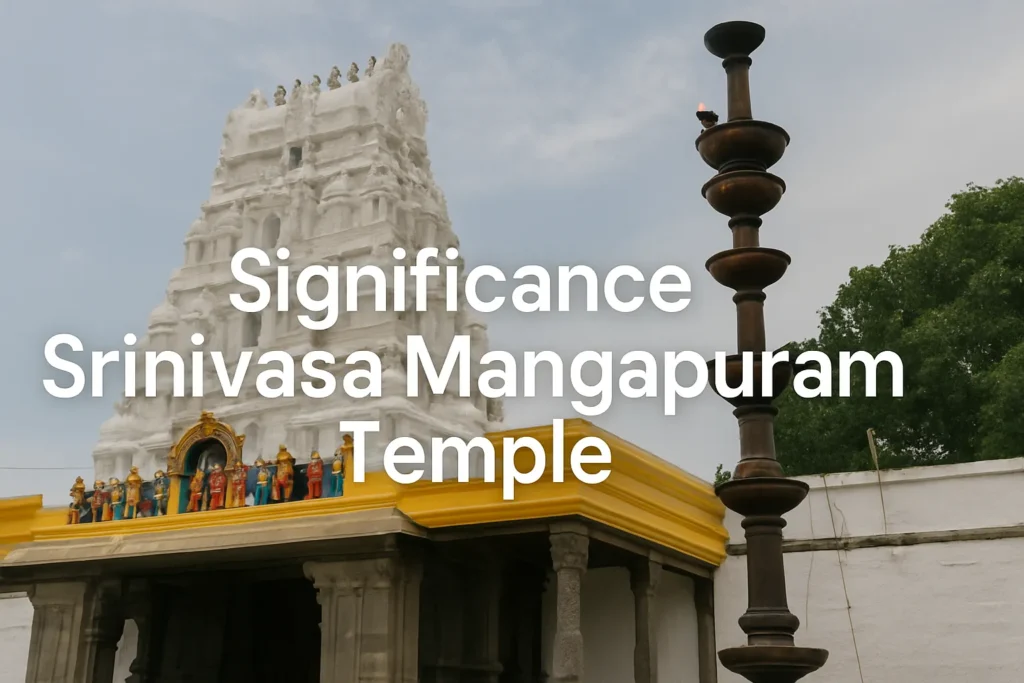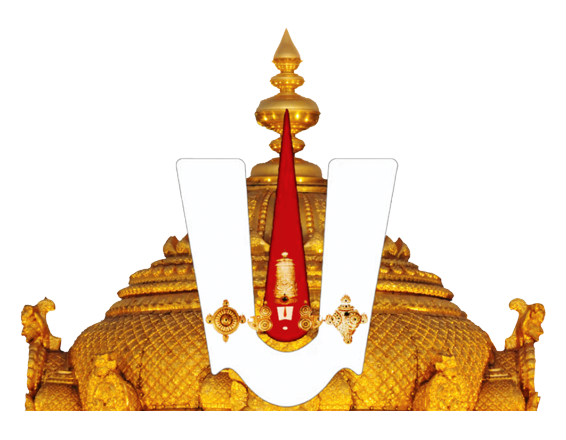Explore the profound significance of visiting Srinivasa Mangapuram Temple before your Tirumala pilgrimage. Discover historical connections, spiritual benefits, and practical advantages that enhance your divine experience at Lord Venkateswara’s sacred abodes.
In the sacred landscape of Andhra Pradesh, nestled amidst serene surroundings approximately 12 kilometers from Tirupati, lies the historically significant Srinivasa Mangapuram Temple. This temple, also known as Kalyana Venkateswara Temple, holds profound religious importance for devotees planning their pilgrimage to the renowned Tirumala temple. As someone who has made this spiritual journey multiple times over the past decade, I’ve experienced firsthand the transformative power of visiting Srinivasa Mangapuram before ascending the sacred hills of Tirumala.

Table of Contents
The Historical Connection Between Srinivasa Mangapuram and Tirumala
Srinivasa Mangapuram Temple dates back to the 14th century and was constructed during the Vijayanagara Empire. According to local historical records, the temple was built by King Thondaman, who also played a crucial role in the development of the Tirumala temple complex. The historical connections between these two sacred sites run deep, creating a spiritual pathway that devotees have followed for centuries.
The temple is dedicated to Lord Venkateswara, the same presiding deity as Tirumala, but here He is worshipped as Kalyana Venkateswara Swamy – the Lord in His divine wedding aspect. This representation commemorates the celestial marriage of Lord Venkateswara with Goddess Padmavati, an event of great significance in Hindu mythology.
According to temple inscriptions examined by the Archaeological Survey of India, Srinivasa Mangapuram served as a temporary abode for Lord Venkateswara during the Muslim invasions of the 14th century, when the deity was moved from Tirumala for safekeeping. This historical refuge adds a layer of reverence to the temple, making it an essential precursor to the Tirumala pilgrimage.
The Ritual Significance: Why Visit Before Tirumala?
The Blessing of Kalyana Venkateswara
One of the primary reasons devotees visit Srinivasa Mangapuram before ascending to Tirumala is the belief that Lord Kalyana Venkateswara’s blessings make the journey to Tirumala more fruitful and obstacle-free. During my first visit in 2014, I observed elderly pilgrims explaining to younger generations that seeking the Lord’s permission at Mangapuram ensures a smooth darshan at Tirumala.
The presiding deity here represents Lord Venkateswara in His married form, symbolizing abundance, prosperity, and fulfillment – qualities that devotees seek in their lives. By receiving these blessings first, pilgrims believe they are spiritually prepared to receive the more austere blessings of the Lord at Tirumala.
The Traditional Pilgrimage Route
Historically, the padayatra (foot journey) to Tirumala included stopping at various sacred sites along the way, with Srinivasa Mangapuram being a mandatory halt. This traditional pilgrimage route, known as “Divya Desam Yatra,” follows a sequence that gradually prepares devotees mentally and spiritually for the culminating darshan at Tirumala.
According to Tirumala Tirupati Devasthanams, the official administrative body of the Tirumala temple, this sequential visitation pattern allows devotees to absorb the different aspects of Lord Venkateswara’s divine persona, making the spiritual experience more complete and profound.
Fulfillment of Vows and Sankalpam
For many devotees, visiting Srinivasa Mangapuram serves as a platform for making sankalpam (spiritual resolutions) before proceeding to Tirumala. During my visits, I’ve witnessed numerous families performing special pujas at Mangapuram, where they articulate their intentions and prayers that they wish to fulfill at Tirumala.
The temple priests at Mangapuram guide devotees through specific rituals that prepare them for the more elaborate ceremonies at Tirumala. These preparatory rituals include:
- Archana (personalized worship)
- Abhishekam (ritual bathing of the deity)
- Kalyanam (symbolic wedding ceremony)
- Tulabharam (weighing against offerings)
Each of these rituals carries distinct spiritual benefits and is believed to enhance the efficacy of prayers offered at Tirumala subsequently.
Architectural and Spiritual Features of Srinivasa Mangapuram Temple
Temple Architecture and Layout
The Srinivasa Mangapuram Temple exemplifies the classic Dravidian architectural style prevalent in South Indian temples. Unlike the massive structure of Tirumala, Mangapuram presents a more intimate setting that allows for a closer connection with the deity.
The temple complex features:
- A main sanctum housing the Kalyana Venkateswara idol
- Separate shrines for Goddess Padmavati and Goddess Lakshmi
- A spacious mandapam (hall) for congregational worship
- Intricately carved pillars depicting scenes from Hindu mythology
- A sacred pushkarini (temple tank) for ritual purification
During my visit in 2018, I spent considerable time admiring the detailed stone carvings that narrate the Puranic stories related to Lord Venkateswara. These artistic expressions not only showcase the craftsmanship of ancient artisans but also serve as visual theological texts that educate devotees about Hindu mythology.
The Divine Idol and Its Significance
The main deity at Srinivasa Mangapuram stands approximately 6 feet tall and is carved from a single black stone, similar to the idol at Tirumala. However, the distinguishing feature is the Lord’s posture and ornamentation, which reflect His kalyana (wedding) aspect.
The idol is adorned with special jewelry, including:
- The Kaustubha gem on His chest
- The divine conch (Panchajanya) and discus (Sudarshana Chakra)
- A special crown symbolizing His status as the divine bridegroom
- The sacred Srivari Vaibhavam (ceremonial garments)
These distinctive features offer devotees a unique darshan experience that complements what they will witness at Tirumala. The contrast between the married Lord at Mangapuram and the more ascetic representation at Tirumala provides a holistic understanding of the deity’s divine attributes.
Practical Benefits of Visiting Srinivasa Mangapuram First
Less Crowded and More Accessible
One of the practical advantages of including Srinivasa Mangapuram in your pilgrimage itinerary is the relatively manageable crowd compared to Tirumala. While Tirumala often requires hours of waiting in queue lines, Mangapuram offers a more peaceful and accessible darshan experience.
During peak seasons, when Tirumala can see waiting times extending beyond 12-24 hours, Mangapuram serves as a meaningful alternative that allows devotees to connect with the same divine presence without the physical strain of extended waiting periods.
Preparation for Tirumala’s Rigorous Environment
The visit to Srinivasa Mangapuram also serves as a physical and mental preparation for the more demanding environment of Tirumala. The higher altitude of Tirumala (at 3,200 feet above sea level) can be challenging for many pilgrims, especially those with health concerns.
By visiting Mangapuram first, which is situated at a lower elevation, devotees can:
- Acclimatize gradually to the pilgrimage atmosphere
- Practice the temple protocols and rituals on a smaller scale
- Build stamina for the longer walks and queue lines at Tirumala
- Mentally prepare for the heightened spiritual experience ahead
Family-Friendly Pilgrimage Experience
For families traveling with elderly members or young children, Srinivasa Mangapuram offers a more accommodating environment. The temple premises are more navigable, the rituals less time-consuming, and the facilities more accessible than the sometimes overwhelming experience at Tirumala.
During my pilgrimage with my elderly parents in 2019, starting at Mangapuram helped them adjust to the pilgrimage routine before tackling the more physically demanding journey to Tirumala. The temple’s peaceful ambiance allowed them to connect spiritually without the exhaustion that often accompanies the Tirumala visit.
Cultural and Community Aspects
Local Traditions and Festivals
Srinivasa Mangapuram has its own rich calendar of festivals and celebrations that complement the major events at Tirumala. The annual Brahmotsavam (temple festival) at Mangapuram is celebrated with great fervor, typically occurring a few weeks before the grand Brahmotsavam at Tirumala.
Other significant celebrations include:
- Kalyanam (divine wedding ceremony) performed every Friday
- Vaikuntha Ekadasi celebrations
- Rathasapthami (chariot festival)
- Pavitrotsavam (purification ceremony)
Participating in these local festivals provides devotees with a deeper understanding of the cultural heritage surrounding the Lord Venkateswara tradition. According to cultural historians specializing in South Indian traditions, these localized celebrations preserve practices that might have evolved differently at the more commercialized Tirumala complex.
Supporting the Local Economy
Visiting Srinivasa Mangapuram also contributes to the sustainable development of smaller religious centers around Tirupati. While Tirumala receives millions of visitors annually, the smaller temples often struggle to maintain their historical and cultural significance without adequate patronage.
The local economy around Mangapuram benefits from pilgrims who:
- Purchase traditional offerings and pooja items from local vendors
- Contribute to the temple’s maintenance through donations
- Patronize local eateries serving traditional Andhra cuisine
- Buy handcrafted religious souvenirs made by local artisans
This economic support helps preserve the traditional ecosystem that has sustained these sacred sites for centuries.
Personal Testimonies and Experiences
Transformative Pilgrimage Journeys
Many devotees report profound spiritual experiences at Srinivasa Mangapuram that enhance their subsequent visit to Tirumala. During my conversations with fellow pilgrims over the years, I’ve collected numerous testimonies of answered prayers, personal transformations, and divine interventions that devotees attribute to their visit to both temples in sequence.
One particularly moving account came from a family from Maharashtra who had been childless for twelve years. After performing specific rituals at Mangapuram followed by prayers at Tirumala, they were blessed with twins the following year. Such narratives strengthen the belief in the complementary spiritual power of these sacred sites.
Celebrity and Notable Visitors
The tradition of visiting Srinivasa Mangapuram before Tirumala has been followed by many prominent personalities, including political leaders, film stars, and sports personalities. Their adherence to this traditional sequence has helped preserve this cultural practice across generations.
According to temple records, notable figures like former President of India Dr. A.P.J. Abdul Kalam, cricket legend Sachin Tendulkar, and various chief ministers of Andhra Pradesh have followed this pilgrimage sequence, underscoring its significance in the public consciousness.
Practical Information for Pilgrims
How to Reach Srinivasa Mangapuram
The temple is easily accessible from Tirupati by various modes of transportation:
- By road: Approximately 12 kilometers from Tirupati bus stand, with regular RTC buses plying the route
- By taxi/auto: Available from Tirupati at reasonable rates
- As part of organized tours: Many tour operators include Mangapuram in their Tirupati package
For those planning to visit multiple temples around Tirupati, it’s advisable to hire a private vehicle for the day, which typically costs between ₹1,500-2,500 depending on the season and vehicle type.
Best Time to Visit
While the temple is open throughout the year, the most favorable periods to visit are:
- September to February: Pleasant weather conditions
- During the annual Brahmotsavam: For experiencing the grandest celebrations
- Early mornings (6 AM to 9 AM): For a peaceful darshan experience
- Weekdays: To avoid weekend crowds
It’s advisable to avoid peak pilgrim seasons at Tirumala (like school holidays or major festivals) if you prefer a less crowded experience.
Accommodation Options
While many pilgrims choose to stay in Tirupati and make a day trip to Mangapuram, there are limited accommodation options near the temple for those wishing to stay closer:
- TTD guest houses (limited availability)
- Private lodges and small hotels in the vicinity
- Dharamshalas (pilgrims’ rest houses) offering basic facilities
For more comfortable stays, Tirupati offers a wide range of options from budget to luxury accommodations, with prices ranging from ₹500 to ₹5,000 per night.
A Holistic Pilgrimage Experience
The practice of visiting Srinivasa Mangapuram Temple before ascending to Tirumala represents more than just a traditional sequence – it embodies a holistic approach to spiritual pilgrimage that honors both historical connections and theological significance. This sequential visitation allows devotees to experience different aspects of the same divine presence, creating a more complete spiritual journey.
As a regular pilgrim to these sacred sites, I can attest to the distinct yet complementary experiences they offer. Srinivasa Mangapuram provides the intimate, preparatory connection with Lord Kalyana Venkateswara, while Tirumala offers the culminating darshan of the Lord in His sovereign aspect.
For those planning their pilgrimage to Tirumala, incorporating Srinivasa Mangapuram into your itinerary isn’t merely following tradition – it’s embracing a richer, more meaningful spiritual experience that connects you to centuries of devotional practice and divine grace.
Whether you’re a first-time visitor or a regular pilgrim, this sacred sequence opens doorways to a deeper understanding of the divine presence that has drawn millions to these hills for generations. As the ancient Tamil saying goes, “Vengadathu Venkatesa, Mangapuram Kalyanesa” – acknowledging the complementary nature of the Lord at both these sacred abodes.
About the Author:
Sri Ananth Kumar Iyengar is a professional storyteller and writer with a deep passion for Indian mythology. For over two decades, he has delved into the legends and lore of temples across India, with a special focus on Tirumala. His writings bring to life the divine tales of Lord Venkateswara and the spiritual history of Tirupati. Known for his engaging storytelling style, Iyengar’s blogs provide readers with a profound understanding of the temple’s historical and mythological importance.
Email: [email protected]

